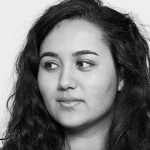
Last year marked the first edition of the esteemed Paris Photo fair in Los Angeles, where after 10 years of success in Paris, the fair came to the sweeping lots and "New York" sets of Paramount Studios. This year's second PPLA (from April 25-27) retained the same Hollywood charm and sense of belonging in the image-conscious, cinematic city, but with a deeper, more holistic examination of photography as a medium. Last year's photo tray images and photograms were replaced by strong explorations of photography as performance, a document of cultural phenomenon, and an indicator of time and space. Although the greats were on view—Guy Bourdin, William Eggleston, Nobuyoshi Araki, and Dennis Hopper among them—they were largely in a separate conversation from the newer talents who most of this year's galleries championed very well.
Throughout the performative video pieces, like Brian Bress' work at Cherry and Martin (he was the only artist tasked with covering their entire wall and ceiling space) and Kate Gilmore's short film at David Castillo, the process of being consumed in one's image and image-making took precedent. Bress appears in most of his looped videos wearing photo-collaged masks using photos he's found or captured himself. He and his characters wear photography, in a similar way to Kate Gilmore's participation in challenging art tasks that examine her own image and practice.

Brian Bress at Cherry and Martin

Kate Gilmore at David Castillo
Many photographers at the fair communicated just as strongly in their examination of youth culture, albeit Ryan McGinley's widely seen grid piece, You and My Friends 4 (Orlando Bloom spent time at team gallery's booth admiring the work), or Virginia Chardin's pieces showing young people with disabilities performing unbelievable stunts. Chardin's work simultaneously explores the limitations of her subjects and the limitations of her medium. McGinley's photographs capture a generation in exhausted awe of musicians at music festivals, completely unaware of the photographer shooting them.

Ryan McGinley at team gallery

Virginia Chardin at De Soto Gallery
Candida Hofer's photographs at Galerie Thomas Zander examine the awkwardness of space and design—spaces that look like they weren't made for human habitation. In a similar exploration of space, Mariah Robertson's pieces at M+B and Kate Bonner's pieces at Luis De Jesus turn photographs into sculptures, offering viewers multiple angles of what are usually flat, two-dimensional surfaces. Ed Ruscha's multi-photograph piece at Koenig and Clinton captures LA parking lots (again, fitting for the location, as many pieces were) and their eerie expansiveness.

Candida Hofer at Galerie Thomas Zander

Mariah Robertson at M+B

Kate Bonner at Luis De Jesus
Ed Ruscha at Koenig and Clinton
In spite of the largely upbeat, photographically advanced images on display, the standout works from this year's edition were possibly the darkest and most "traditional"—the LAPD Archive and Alain Declerq's works at Loevenbruck Gallery. All black and white, the LAPD images were not made to be art objects and were not meant to appear staged (yet so many still did). Although they were the most gruesome images at the fair, they provided the most "real," documentary images in confusing, calculated-looking positions. Declercq's pinhole images and map portray the hysteria and paranoia surrounding government surveillance, at a time when privacy seems nonexistent and many cameras are being used for evil instead of good. In this sense, photography becomes much less about identity, space, and history and more about loss, politics, and the uncertain future.

Photo from the LAPD Archives


Alain Declerq at Loevenbruck Gallery
Nearby sat the David Hockney BMW art car, whose back story may be one of the most intriguing in their collection to date (he asked for his own model of the car with a special seat and water container built in for his dachshund). Meant to show viewers an abstract look at the car's interior from the exterior (as well as his dog), the 850CSi, completed in 1995, carries the same spirit of wonder and adventure as the accompanying photographs at Paris Photo LA. On the heels of the 40-year anniversary of the BMW art car (the celebratory book comes out in June), highlighting Hockney's legacy as a traveling, endlessly captivating felt very appropriate.
It was Hockney who said, "I paint what I like, when I like, and where I like," and many of PPLA's photographs share the sentiment. There were no boundaries for documenting and creating from the bright and dark sides of humanity, while also taking a more contemplative look at the medium and how far it's come.
Until next year.

The David Hockney BMW Art Car


